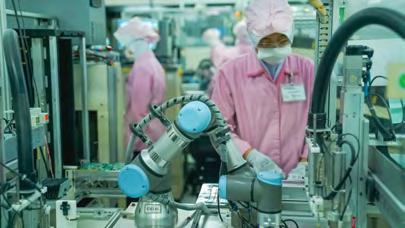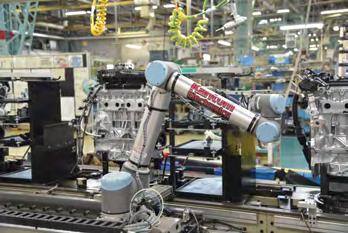
5 minute read
Collaborative robots spark radical shift towards making work more human
COLLABORATIVE ROBOTS SPARK RADICAL
SHIFT TOWARDS MAKING WORK MORE HUMAN
Advertisement
by Kim Povlsen, President, Universal Robots
A leading company in this field provides an overview.
Mr Kim Povlsen
When I joined Universal Robots (UR) as President earlier this year, I knew I was coming in to lead a fast-growing company in a ground-breaking sector. The more I see of collaborative automation, the more I am convinced that the technology can solve many of the problems faced by the manufacturing sector today. People are becoming more aware of this potential and that is driving strong demand for cobots. As the need for cobots grows, our technology is becoming more versatile than ever before and we are able to offer more across a wider range of industries. The world has gone through an extraordinary couple of years as it has adapted to the pandemic. I think COVID-19 has highlighted the need for resilience in the manufacturing sector - supply chain problems especially have forced companies to look more closely at their production processes. Meanwhile, we are seeing workforce challenges in manufacturing across all the regions we work in, caused by an ageing workforce and young people making different career choices. Automation has an important role in solving these challenges. Collaborative robots can work alongside staff, increase productivity and make manufacturing jobs more attractive to workers. When employers introduce cobots, we see them upskill their existing employees and the nature of the work changes. Staff take on more responsibilities with creative, problem-solving and communication elements, that only humans can handle, while operating the cobots to complete repetitive tasks. These changes result in increased work satisfaction and better career advancement opportunities amongst the employees. In the post-pandemic world, people are starting to rethink the kind of work that should be done by humans. The jobs in manufacturing, assembly and operations are often dull, dirty and dangerous. Now, collaborative automation is paving the way for the workforce to take on more interesting jobs. With cobots working alongside them, employees are becoming adept cobot operators, assigning cobots to work on repetitive tasks while they spend more time devising innovative strategies. This trend of changing job scope can help to retain the workforce for companies, while relieving employees of
work which is unfulfilling or physically demanding. I am so excited to be leading a company that empowers this change in the way that work is done. I often get asked about the challenges we face as a company. We have sold well over 50,000 cobots since the first cobot in 2008. You can now find UR offices in over 20 countries and our cobots can be found in almost every part of the world. But in many ways, we are only just getting started. We look at the challenges facing manufacturing and we know from our market analysis that there are tens of millions of people working in jobs including tasks that are automatable with cobots. The key challenge is therefore in spreading awareness of cobots and developing confidence in using the technology. In recent years, we have started working with schools and colleges to help develop the robotics skills needed by the next generation of engineers and production workers. UR has also created educational online training accessible to anyone interested in learning about the use of cobots. Our training for cobot operators builds confidence in everything from basic tasks to much more complex processes. This is really the starting point in our company’s commitment to every customer’s success. You might think that our technology has now reached a stage of development where the emphasis is on production rather than research and development but, in fact, our research and development work has never been stronger. We are working every day to refine our technology and to continue to innovate. Our colleagues, across innovation, research and development, and product design, work to continuously redefine automation. I am really committed to hiring the best engineering talent from across the world and then empowering those engineers to solve the problems facing the manufacturing sector. We set out to ensure that everyone using our cobots has a positive and frictionless experience and this means putting customer experience at the heart of everything we do. Our teams have constant contact with end-users to understand their needs and desires. Customers turn to cobot technology for different reasons, and we see different drivers across the world, depending on local economies and industries. In Asia, companies often choose UR to increase quality in production, to build resilience and maintain a competitive edge. We work with many companies in Asia, that are making expensive products, where the cost of mistakes is very high. Our cobots give companies the ability to increase consistency and reduce waste. People have been less mobile since the pandemic started and we know some companies also value the certainty that comes with increasing automation. Our success at UR is the product of our collaborative business model. The best way of understanding this model is to look at a smart phone – great technology, but the real leap forward in the way we live has come from the technical platform that has allowed independent companies to develop compatible applications to cover every conceivable human need. Our cobot technology creates similar opportunity. We now work with over 290 independent partners who design and develop components and applications for our cobot. This is the only way to create the range of technology at the pace of development demanded by the market. This collaboration is the only reason we see cobots now working on tasks such as sanding and welding that were previously believed to be impossible to perform with collaborative automation. The number of independent developers involved also creates real choice for our customers, which they can match to their unique business needs. Moving forward, we foresee an exciting year ahead as UR continues to grow in Asia Pacific. The technological capabilities of UR cobots along with the applications and components developed by our partners are constantly evolving. One of my primary goals as the President of UR is to ensure that we continue to innovate and further lower the automation barrier for companies of all sizes. Cobots have proven to provide a promising future for many companies. As cobots permeate the mainstream, we believe that companies will continue to reap the rewards which include increased revenues, improved production quality, and a safe working environment.


UR10 cobots offer the solution for an ageing workforce and reduce relief worker costs for a global car manufacturer, Nissan Motor Corporation. PT JVC Electronics Indonesia improved productivity and performance quality while reducing yearly operational costs by USD 80,000, with UR3 cobots.

